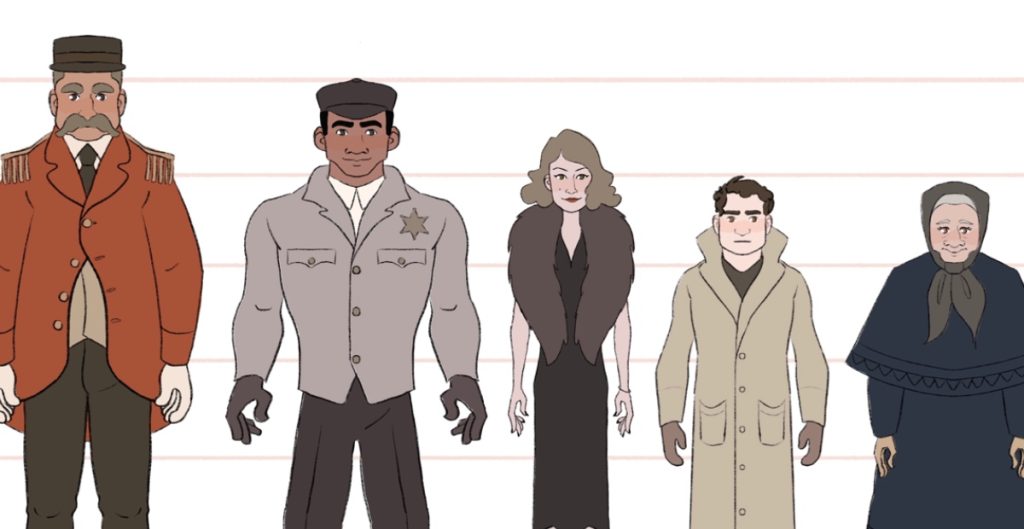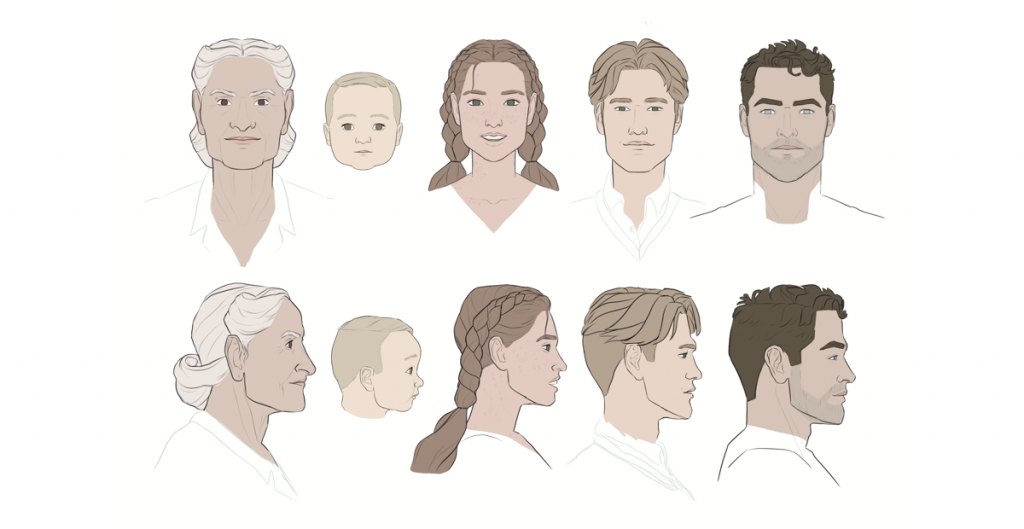Same Face Syndrome – How to Create Distinct Looking Characters
Same face syndrome is a problem that plagues a lot of artists. It is the struggle to create distinct looking faces. This problem can be a bother for beginner to advanced artists alike. When an artist draws all their faces the same way it can come off as lazy, unoriginal, or under-skilled. Additionally, it can be hard for people to tell apart characters with similar faces. Moreover, when characters are all drawn the same they lack the ability to be memorable.
But there is no need for you to fret about creating distinct faces anymore. This article covers three main solutions to overcome same face syndrome: Firstly, learn how to use anatomy to prevent same face syndrome. Secondly, learn about using varying levels of attractiveness as a cure. Thirdly, learn how to use stylistic choices as a cure. Furthermore, you will also learn what to do when nothing else seems to be working. So, continue reading to learn about each of these solutions.
1. Understand Anatomy to Prevent Same Face Syndrome
One easy way to defeat same face syndrome is to learn facial anatomy. By understanding the anatomical differences between faces you will be able to draw faces that are unique from each other. So, here is a list of topics to study that will help you to draw more distinct faces:
- Try studying the bones of the head and differences in bone structure.
- In addition, study different eyes, eyebrows, jaws, cheeks, teeth, noses, lips, ears, hair, facial hair, etc.
- Likewise, try to learn different facial proportions, angles, shapes, sizes, and silhouettes.
- As well, practice creating a variation of face types, from thin, to average, to overweight.
- Another idea is to learn how to draw different ages of faces, from young, to middle age, to old.
- Also, study the stereotypical differences of feminine versus masculine faces.
You can learn about most of those topics for free on the internet. However, there is a better option for artists looking for an easier and faster way to improve anatomy. And that is one of my favorite facial anatomy drawing books. The book is Drawing the Head and Hands by Andrew Loomis. It goes into so much detail about facial anatomy. As well, it is my biggest source of knowledge for drawing heads. So I do recommend it for artists that are serious about improving. #affiliatelink
Study Real Life
Additionally, to improve your ability to draw faces with distinct anatomy you should study real life. Do not be afraid to practice using references. Try to observe the people around you. Take note of what makes the people in your life look different. Later, you can apply some of those differences to your characters, so they will look different as well.
Give Characters Unique Facial Expressions
Another idea to help your drawings of faces look different is to give them unique facial features. Not everyone smiles the same way. Nor do they display anger the same way. But you get the point. So, next time you draw faces, be sure give them some personality. This will help each face to stand out from each other.
Use Multiple Ethnicities
Furthermore, drawing faces with different ethnicities will help them to look different. People with different heritage naturally look different from each other. For instance, European, Asian, African, etc. people usually quite different from each other. Each of these ethnicities have traits that are more common to them. For example, certain types of eyes, eyebrows, jaws, cheeks, noses, lips, ears, hair, etc. So, you can try incorporating different ethnic traits into your characters to help them look different from each other.
Apply What You Learn
Furthermore, after improving your understanding of anatomy, it is time to apply it. So, try to give each of your characters at least one memorable trait. By giving them each a distinctive feature you will cure your same face syndrome. Now, people will be less likely to confuse your characters or say they all look the same.
Below, you can see some examples of practicing making faces look different. On the left, simple shapes help give each face a different look. On the right, is practice at drawing a face at different ages. These are both great exercises to help you understand how to create distinct looking faces.

2. Use Varying Levels of Attractiveness to Cure Same Face Syndrome
A more straightforward way to cure same face syndrome is to incorporate varying levels of attractiveness into your characters. You have probably noticed that lead characters and heroes are often depicted as super cute, handsome, or gorgeous. However, when every character’s face induces jaw dropping, same face syndrome can arise.
So, try not to create just model-level faces. Instead, draw some average looking people too. As well, draw some people that have homely, ugly, scary, deformed, or even evil looking faces. Moreover, you can still create attractive faces. Just try to make them appealing in their own ways. Maybe you give one face cute proportions, whereas you give another beautiful eyes, and you make another super chiseled.
Below, you can see some faces I designed for my comic, Derailed. When designing these characters, I did not worry about making them all attractive. Instead, I put my focus into making them unique. Nonetheless, they all are compelling in their own ways.

3. Break Free from Stylistic Problems Causing Same Face Syndrome
Another solution to same face syndrome is to break free from stylistic problems. Sometimes, artists get stuck in a comfort zone. They draw the same faces over and over because that is what they are good at. And because they feel like certain looks are a part of their style.
However, artists suffering from same face syndrome need to try a few new things. For instance, try experimenting, exploring, and expanding the types of faces you draw. In addition, try to add some variation to your style. Another idea is to practice caricaturization and exaggeration. Similarly, break free from standard formulas for drawing heads. There is no one correct distance between eyes or correct width for faces.
Avoid Popular, Overly Used Designs
What is more, if trying to make distinct looking faces, avoid using overly popular styles.
You may have heard of “anime face.” This is a term to describe the problem of anime faces tending to look super similar. A lot of times you can only tell two anime characters apart by their hair color. Likewise, you may have heard of “Glen Keane face” or “Disney face.” These are terms to describe how a lot of Disney princess look similar. There is nothing inherently bad about these styles. However, if you do not want to get called out for same face syndrome, you should probably avoid these styles.
Beneath this paragraph are some examples of characters all in the same style. Yet, these characters all still have unique faces. I need these characters to look unique, as they are the main cast of my comic, Kindred Not. As well, I want these characters to look different than the ones from my previous comic. To achieve this, I avoided using a style like “anime face” or “Disney face.” Rather, I tried to create my own unique style.

When All Else Fails at Creating Distinct Faces
Despite trying the previous suggested solutions, are you still struggling to cure your same face syndrome? Well then, read on for a few more ideas.
Facial Blindness
Some people suffer from facial blindness or Prosopagnosia. If you are an artist with this problem, it might be quite annoying. For you, same face syndrome may seem impossible to overcome. But, even if you have facial blindness, there are still some things you can try to create distinct looking characters.
For instance, try to compensate for this problem by making your characters recognizable in other ways. Give them each unique outfits or hair colors. Another idea is to practice improving your facial blindness. There are exercises you can try to improve your ability to recognize faces. Hopefully, one of these ideas will help you. If not, read on.
Add Extras
One workaround for same face syndrome is to add extras. If you cannot, or do not, want your characters to have unique facial structure, you can still make them unique in other ways. For example, try adding piercings, scars, glasses, masks, hats, or helmets. This will give each character something different about them, even if they have similar faces.
Take it with a Grain of Salt
Finally, same face syndrome is often seen as a negative thing. That said, it does not have to be seen that way. People often mix up siblings and celebrities, even in real life. Also, same face syndrome can actually be useful as a branding technique.
So, take criticism of same face syndrome with a grain of salt. And if you enjoy having characters with the same faces, just own it. Confidence can work wonders.

Summary of Same Face Syndrome
To sum things up, this article discusses three cures to same face syndrome. Firstly, learning anatomy. Secondly, using attractiveness in different ways. Thirdly, taking certain stylistic choices. Moreover, it gives some ideas when nothing else seems be helping.
How will you cure your struggles with same face syndrome? Leave a comment below. Also, share this article with your artist friends so they can learn from it too. And more for content like this, subscribe to my blog.
For even more tips on drawing faces, check out these tips for making character reference sheets. And for more examples of distinct looking faces, check out some character turnaround sheets I made for my comic. Finally, be sure check out my comic, Kindred Not.


Discussion ¬